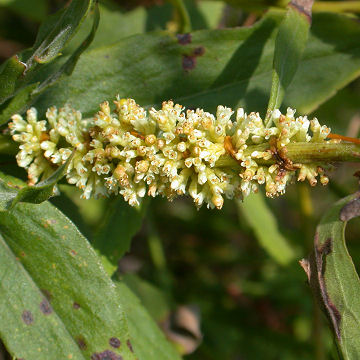

Cuscuta cephalanthi - (image 1 of 3)
Taxonomy
Family: Convolvulaceae
Habitat
Low, wet areas including fens.
Associates
Parasitic on Cephalanthus occidentalis (hence the common name), Justicia americana, Aster puniceus, Aster simplex, and Salix interior. Swink and Wilhelm (1994) also list several weedy species on which this plant has been found, including Campsis radicans, Daucus carota, and Solanum dulcamara.
Distribution
ME west to WA, south to FL and NM.
Morphology
Achlorophyllous, parasitic annual. Stems yellow to orange, glabrous, infecting host with haustoria. Leaves absent. Flowers sessile in compact clusters; perianth dull, mostly 4-merous; corolla lobes obtuse, erect, persisting on capsule; sepals united above their bases; calyx not subtended by bracts. Capsules wider than long.
Notes
Flowers August to September
Wetland Indicator: Facultative Wetland
Endangered in NY and NJ but considered a weed in many others (presumably because it is parasitic).
References
Gleason, Henry A.
and A. Cronquist. 1991. Manual of Vascular Plants of Northeastern United States
and Adjacent Canada. Second Ed.
The New York Botanical Garden. Bronx, NY
Swink, F. and G.
Wilhelm. 1994. Plants of the Chicago Region.
Indiana Academy of Science. The Morton Arboretum. Lisle, Illinois.
USDA, NRCS. 2002. The PLANTS Database, Version 3.5 (http://plants.usda.gov).
National Plant Data Center, Baton Rouge, LA 70874-4490 USA.
|
Michael Hough © 2009 |